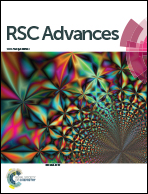In vitro effects of differentially shaped hydroxyapatite microparticles on RAW264.7 cell responses
Abstract
While numerous reports demonstrated that the properties of hydroxyapatite (HA) particles affect its biological effects, the potential role of particle shape is drawing more and more attention and concern. The present report aims to investigate the effects of microrod and microsphere HA particles on RAW264.7 cell responses in vitro. The two shaped HA particles were synthesized by a hydrothermal method and pH regulation, and then characterized by scanning electron microscopy (SEM). The cytotoxicity to RAW264.7 cells was assessed on LDH release with HA particle concentrations at 200 μg mL−1, 500 μg mL−1 and 1000 μg mL−1. Based on the similar effects for the different concentrations, 1000 μg mL−1 concentration was selected for further investigations and Live/Dead staining was then used to observe the cell viability for 24 h. Furthermore, particle–cell association and cell apoptosis were detected by Alizarin Red staining and western blot analysis, respectively. Cell proliferation was performed by a CCK-8 test for 5 days. Moreover, to explore the effects of particle shape on differentiation, RANKL induced RAW264.7 cell osteoclastogenesis was investigated through qRT-PCR analysis on related genes (RANK, TRAP, MMP-9 and CTSK) and the NF-κB signaling genes' (IκBα, IKKβ, c-Fos and NFATc1) expressions for 6 days. In the results, we found that microrod and microsphere HA particles had no difference on the viability of RAW264.7 cells at early co-incubation time (within 24 h), but microrod particles triggered more striking non-specific cellular uptake or contact with RAW264.7 cells and induced an increased apoptotic signal. Moreover, compared to microsphere particles, microrod particles initiated more conspicuous proliferation inhibition and interfered with the osteoclastic differentiation process profoundly with down-regulation of osteoclastogenesis-related and NF-κB-related gene levels. Our results indicate a shape-dependent effect of HA particles on cellular response of co-cultured RAW264.7 cells in vitro, and may provide more understanding towards the potential role of HA wear debris shapes in vivo.


 Please wait while we load your content...
Please wait while we load your content...